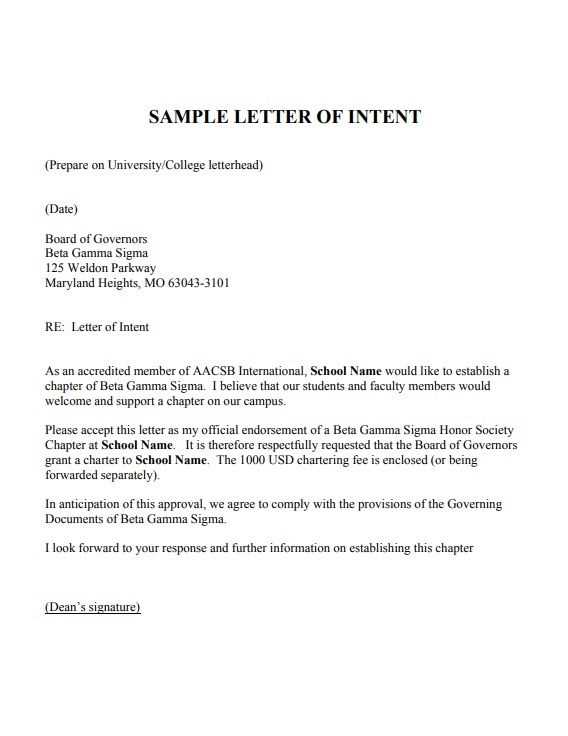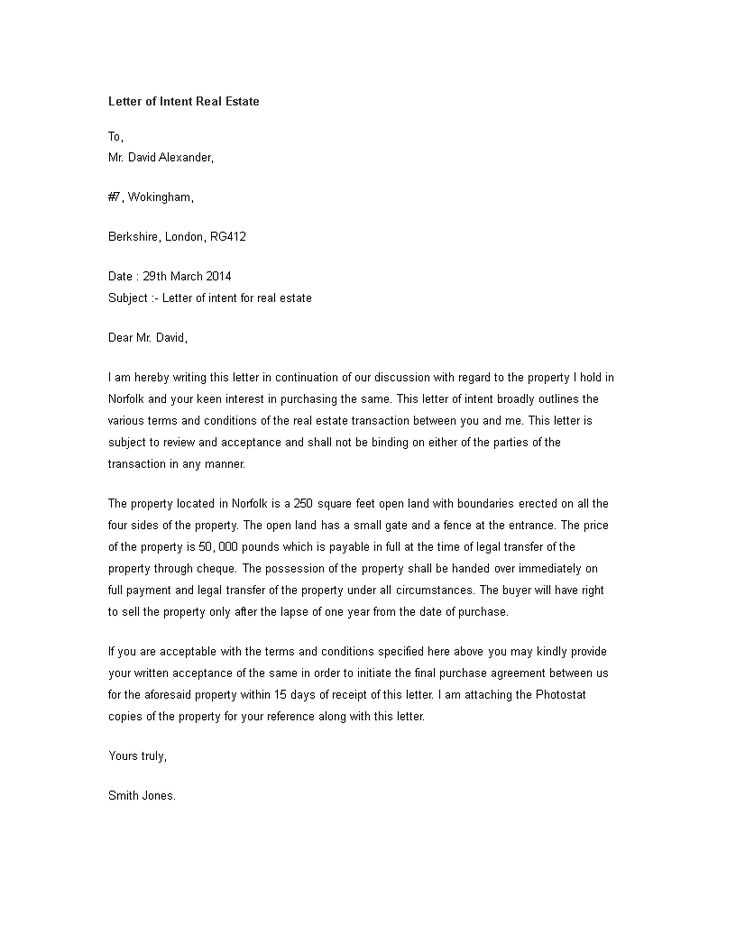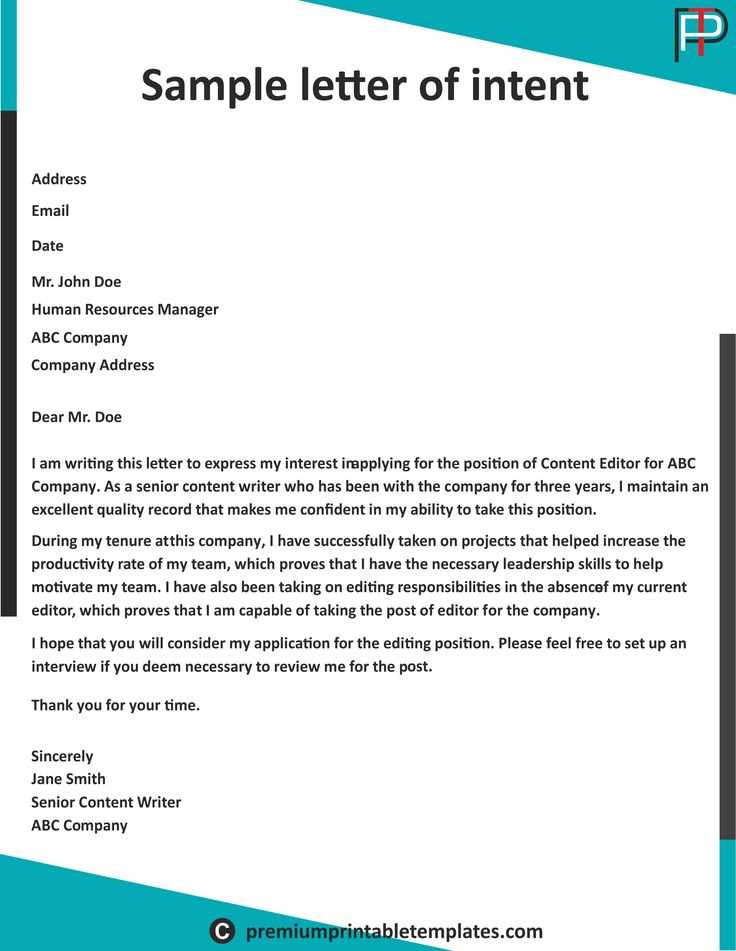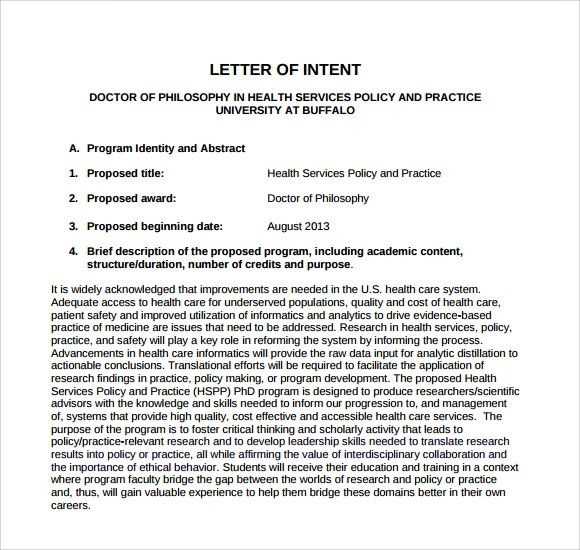Letter of intent university template

Crafting a letter of intent for university admission is an important step in the application process. A well-written letter presents your motivation, academic goals, and why you are a good fit for the program. Begin by directly addressing the admissions committee, expressing your interest in the specific program, and highlighting your relevant academic achievements. Be clear about your purpose and outline how the university aligns with your future aspirations.
In your letter, focus on personal experiences that demonstrate your commitment to academic and professional growth. Instead of generic statements, highlight specific skills or projects that set you apart from other applicants. Also, mention how the university’s unique resources, faculty, or research opportunities will help you achieve your goals.
Conclude with a brief yet confident statement about your desire to contribute to the university community. Restate your enthusiasm and ensure your letter reflects your genuine interest in the program. Proofreading your letter for clarity and correctness is just as important as the content itself, as a polished letter will leave a strong impression.
Letter of Intent University Template
Crafting a letter of intent for university applications requires clarity and directness. Start by introducing yourself, specifying the program you are applying for, and briefly explaining why you are interested in it.
Introduction
In the first paragraph, mention your academic background, current studies, and any relevant achievements. Highlight what drew you to this specific program and university. Show that you have researched the institution and that it aligns with your academic and career goals.
Academic and Professional Background
Next, describe any experiences, internships, or research projects that demonstrate your qualifications for the program. Be specific about how these experiences have prepared you to succeed in your studies and how they relate to the program’s focus.
Finish by discussing your long-term goals and how attending this university will help you achieve them. End with a statement of gratitude for the opportunity to apply and express your eagerness to contribute to the academic community.
Here’s a simple structure to follow:
- Introduction: Briefly introduce yourself and your intentions.
- Academic Background: Mention your achievements and relevant experiences.
- Career Goals: Explain how the program aligns with your future plans.
- Closing: End with a statement of appreciation and anticipation.
This structure ensures that your letter remains focused and easy to read, showcasing both your qualifications and enthusiasm for the program.
What to Include in the Body to Highlight Your Academic Achievements
Include specific academic accomplishments such as high grades, scholarships, and awards that show your dedication and success. Mention any honors or distinctions you’ve received, especially those that set you apart from your peers.
Courses and Projects
Highlight any advanced courses, special projects, or research you’ve undertaken. Detail how these experiences expanded your knowledge or skills in your field of interest. For example, if you completed a complex research paper, explain its relevance and the results you achieved.
Academic Leadership

Showcase leadership roles within academic groups, clubs, or committees. If you organized study groups, led a team for a competition, or presented at a conference, mention these achievements to reflect your initiative and ability to work with others.
Be specific in your descriptions. Use concrete examples that demonstrate how you’ve excelled and how these experiences will contribute to your success in the program you are applying to.
How to Clearly Articulate Your Career Goals and Academic Interests

Be specific and direct. Your career goals and academic interests should reflect your true aspirations and motivations, not generic phrases. Show how your academic pursuits align with your long-term career vision.
Begin with a clear statement of what field or industry you want to work in. Avoid vague references; instead, focus on a niche or area where you feel passionate and skilled. For example, instead of saying “I want to work in business,” state, “I aim to manage supply chain logistics in the global tech industry.” This shows clarity and purpose.
Next, explain why this field appeals to you. Link it to personal experiences or accomplishments that led you to choose this path. This could be a project, a class, or a real-world scenario where you felt engaged or challenged. This personal connection helps demonstrate your commitment to the field.
Outline your academic plan with specific goals. Mention courses, research opportunities, or professors you want to work with, and explain why these align with your goals. This demonstrates that you’ve thoroughly researched the program and are focused on how it will help you succeed.
- Identify specific skills you want to develop.
- Link academic goals with practical applications in your desired career.
- Show how your chosen university’s resources will support your growth.
Finally, address how your long-term career goals will contribute to the broader field or community. Think about the impact you want to make and how your education will help you achieve that. This can help convey a sense of purpose and direction.
Customizing Your Letter for Different University Programs

Tailor each letter to highlight how your skills and aspirations align with the specific program. Focus on the unique aspects of each program that excite you and relate them directly to your academic background and professional goals. For instance, if applying for a research-based program, emphasize your experience with independent research, while for a more hands-on program, highlight your practical skills or past internships.
Research the program thoroughly and mention any faculty members whose work resonates with your interests. Show how their expertise complements your aspirations. Customizing your letter in this way demonstrates that you’ve taken the time to understand the program and how it fits your career path.
Be specific about what the program offers that other programs might not. If the university provides unique opportunities for networking, specialized equipment, or a distinct approach to teaching, make sure to explain why these factors are significant to your goals. This shows the admissions committee you are genuinely interested in what they offer.
Each program might prioritize different qualities, so adjust the tone and content accordingly. A more technical program may value analytical skills, while a creative field could require demonstrating innovation and adaptability. By addressing these differences, you increase your chances of standing out.
What to Avoid When Writing Your Letter of Intent
Don’t make the mistake of using generic language or vague statements. Focus on clear, direct communication. Instead of saying you are “passionate” or “dedicated,” demonstrate those qualities through specific examples. Show how your background aligns with the program or position you’re applying to by detailing relevant experiences, rather than relying on abstract terms.
Avoid Being Too Broad
Stay away from making sweeping generalizations. For instance, avoid saying “I want to be successful in my field.” Focus on concrete achievements or goals that connect to the program or organization you’re writing to. Explain how their values, focus, or approach resonates with your aspirations.
Don’t Overload With Personal Information
While personal stories can help illustrate your motivation, avoid including irrelevant details. Keep the letter focused on your academic or professional qualifications. Avoid stories that do not directly relate to your application, as this can detract from the main message you are conveying.